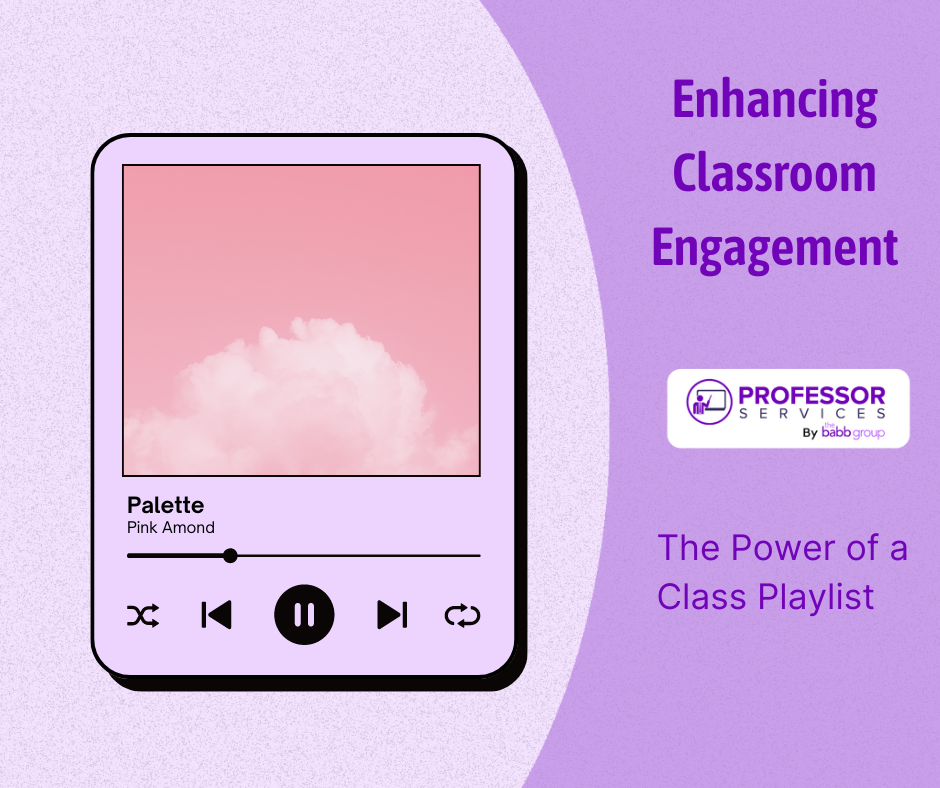
“Help!” I texted teacher friends.
How do you keep them engaged?
How do you keep them awake?
How do you keep them coming to class?
Responses included coffee, snacks, donuts, don’t lecture, making them get up and move around, putting them in groups, and other engaging tried and true ideas from college professors and high school teachers. All of these were successful, especially the early morning stops at Dunkin.
A class playlist is more than just a collection of songs. It’s a carefully curated selection of music that complements the learning experience and encourages community.
I teach communication courses, which lends itself to starting the first day of any in-person class with interviews. Students work in pairs or triads, working through a list of questions together, then introducing one another. The exercise has several objectives. It gets students talking on the first day and gives me data on students so I can tailor the class to their career interests and needs. Questions vary depending on the class but always end with:
What two songs would you add to the class playlist?
I take the information home, and my daughter builds the class playlist on Spotify, complete with an image for that particular class. If she can’t find their song, she finds a replacement.
At the next class, students are greeted with music from a speaker or on the screen where they can see the playlist.
As they enter, someone will say, “Hey, that’s my song!” This leads to affirmations from other students like, “I love this song.” “I saw them in concert.” There’s always one, “Why country?”
It usually takes a couple of classes until they realize it’s their playlist.
Magic starts to happen.
They get excited when they hear their song. They feel heard. They sing along. Others join in. Stories are shared. Collaboration sparks. Community builds.
One semester the playlist became part of the curriculum. The topic was cancel culture, and Kanye West was canceled that week. We officially removed him from the playlist.
I observe and experience the benefits with my students, but there’s also science to back up the power of using music in your classrooms.
Enhancing Engagement
Music engages us emotionally and intellectually. A class-curated playlist can create an atmosphere that stimulates students’ interest and helps them focus on the lesson. Music can also evoke positive emotions, fostering a sense of enjoyment and motivation, ultimately leading to enhanced learning outcomes.
Creating a Positive Learning Environment
A class playlist sets the tone for the class. When students offer suggestions, you end up with various genres and styles, catering to diverse student preferences and making everyone feel represented and valued. This inclusivity promotes a sense of community and can build positive relationships between you and your students.
Memory Enhancement
Music has a powerful impact on memory. Students retain information more effectively by associating specific songs or melodies with particular topics or concepts. Playing a familiar song before starting a lesson or during activities can trigger students’ recall of previous lessons, strengthening their overall understanding and retention.
Energizing Transitions and Breaks
You know the transition moments between activities or when the class needs a break. No matter the learner’s age, these moments are necessary but disruptive, and refocusing can be challenging. A well-curated class playlist can help smooth these transitions by providing a consistent and energetic background. Upbeat songs during breaks can get the energy going in the room again and rejuvenate productivity.
Using a Class Playlist Effectively
To reap the full benefits of a class playlist, consider the following tips:
Curate with Care: Select songs that align with the school’s values. Ensure that the lyrics, mood, and tempo are appropriate for the learning environment. If students have not added any ambient music, add a few songs to the list for when you need to minimize distractions.
Involve Students: Encourage student participation in the creation of the class playlist. Allow them to suggest songs. Add your own songs so they can get to know you. They will surprise you by loving your favorite 90s classic. This collaborative approach fosters a sense of ownership and investment in the learning process.
Reflect Diversity: Include a variety of music genres, reflecting the diverse backgrounds of your students. This exposes them to new musical experiences and promotes cultural understanding and appreciation within the classroom. In one classroom, students’ ages ranged from 17-50. Appreciating one another’s music bridged the generation gap.
Mindful Volume: Ensure that the volume of the music is appropriate, so students can hear one another and you’re not disrupting nearby rooms. Background music should enhance the learning experience, not serve as a distraction.
Integrating a class playlist into your teaching toolkit can revolutionize classroom dynamics and enhance student engagement. Thoughtfully curating music that aligns with your teaching objectives can create a positive, inclusive, and energized learning environment.
Angela
Latest posts by Angela (see all)
- The Art of Connection: Networking and Professionalism in Academia - July 25, 2024
- Got the Teaching Job? Now, You Need To Attend the Faculty Training - July 1, 2024
- Higher Education Trends: Insights from Our COO, Sheila Fry - June 20, 2024
